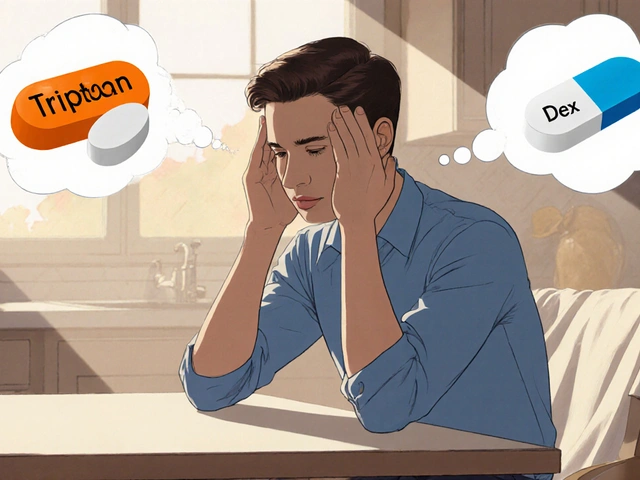Warfarin-Antibiotic INR Risk Calculator
How This Calculator Works
Based on clinical evidence, this tool estimates INR increase when taking common antibiotics with warfarin. Results are approximate and should not replace medical advice.
Why Antibiotics Can Make Warfarin Dangerous
Warfarin isn’t like most blood thinners. It’s old, powerful, and unforgiving. A tiny change in your dose - or what you’re taking alongside it - can send your INR skyrocketing, putting you at serious risk of internal bleeding. And one of the most common triggers? Antibiotics.
It’s not just a theoretical risk. In the UK and US, antibiotics are responsible for 15% to 30% of all warfarin-related hospitalizations. That’s not rare. That’s routine. If you’re on warfarin and your doctor prescribes an antibiotic, you’re not just getting a new pill. You’re stepping into a minefield.
How Antibiotics Mess With Warfarin
There are two main ways antibiotics interfere with warfarin. One is direct - they block the liver enzymes that break down warfarin. The other is indirect - they kill off the good bacteria in your gut that make vitamin K.
Warfarin works by blocking vitamin K, which your body needs to make clotting factors. Normally, about 10-15% of your vitamin K comes from bacteria in your intestines. When antibiotics like amoxicillin/clavulanate or cefotetan wipe out those bacteria, your vitamin K drops. That means warfarin becomes stronger, even if your dose hasn’t changed.
Other antibiotics, like ciprofloxacin, erythromycin, and Bactrim, work differently. They block CYP2C9, the main enzyme that clears the more potent form of warfarin (S-warfarin) from your blood. When that enzyme slows down, warfarin builds up. INR can jump from 2.5 to 4.1 in under a week. That’s not a small bump. That’s a red flag.
Which Antibiotics Are Most Dangerous?
Not all antibiotics are created equal when it comes to warfarin. Some are high-risk. Others are low-risk. Knowing the difference can save your life.
- High-risk antibiotics: Ciprofloxacin, levofloxacin, erythromycin, Bactrim (sulfamethoxazole/trimethoprim), amoxicillin/clavulanate, cefotetan, cefoperazone. These can raise your INR by 1.5 to 2.2 units on average. Ciprofloxacin alone increases bleeding risk by more than double.
- Medium-risk: Azithromycin (much safer than erythromycin), clarithromycin. Azithromycin barely affects INR, but clarithromycin still carries risk.
- Low-risk: Penicillin G, ampicillin, ceftriaxone, nitrofurantoin, fosfomycin, tedizolid. These rarely cause INR spikes and are often safe to use without dose changes.
- Special case - Rifampin: This one does the opposite. It speeds up warfarin breakdown. Your INR can crash below 1.5, making you vulnerable to clots. If you’re on rifampin, your warfarin dose may need to go up by 50-100%.
Don’t assume an antibiotic is safe just because it’s common. Amoxicillin/clavulanate is one of the most prescribed antibiotics in the world - and it’s one of the top three culprits behind warfarin-related ER visits.

When Do INR Spikes Happen?
Timing matters. If you think you can just check your INR once and be done, you’re wrong.
CYP enzyme inhibitors (like ciprofloxacin) cause INR spikes within 48 to 72 hours. That’s fast. You need your INR checked within 3 days of starting the antibiotic.
But gut flora disruption? That’s slow. It takes 5 to 7 days for vitamin K levels to drop enough to affect warfarin. And the effect doesn’t end when you stop the antibiotic. It can linger for another 7 to 10 days. That means even after you finish your pills, your INR could still rise.
Studies show bleeding risk peaks between days 8 and 14 of antibiotic use. That’s why checking INR only at the start isn’t enough. You need monitoring at the start, during, and after.
What Should You Do? A Practical Plan
If you’re on warfarin and your doctor prescribes an antibiotic, here’s what you need to do - right now.
- Ask your doctor: "Is this antibiotic safe with warfarin?" If they’re unsure, ask for a low-risk alternative like ceftriaxone or nitrofurantoin.
- Get your INR checked within 72 hours of starting the antibiotic - no exceptions.
- Check again 5-7 days later, even if you feel fine. This catches the delayed gut flora effect.
- Check again 3 days after finishing the antibiotic. INR can still climb after you stop taking it.
- Watch for bleeding signs: Unexplained bruising, nosebleeds that won’t stop, red or dark urine, black or tarry stools, severe headaches, dizziness. Call your anticoagulation clinic immediately if any of these happen.
- Don’t adjust your warfarin dose yourself. Let your pharmacist or anticoagulation team handle it. They know how much to reduce or increase based on your INR trend.
Many clinics now use pharmacist-led warfarin management during antibiotic therapy. Studies show this cuts bleeding complications by 37%. That’s not a small win. That’s life-saving.

What About Electronic Alerts?
You might think your EHR will warn your doctor if you’re on warfarin and they prescribe ciprofloxacin. It should. But it often doesn’t.
A 2019 study found that simple pop-up alerts in electronic systems reduced bad events by only 7%. But when those alerts were paired with clinical decision support - like a pharmacist automatically reviewing the case - the drop jumped to 22%.
Don’t rely on your system to catch this. Be your own advocate. If you’re on warfarin, assume every antibiotic is risky until proven otherwise.
What’s Changing in the Future?
Genetics might soon change how we manage this. Some people have a CYP2C9*2 or *3 gene variant that makes them extra sensitive to warfarin. When they take an antibiotic, their INR can spike 2.4 times higher than others.
The 2023 WARF-GEN trial showed that if you test for these genes before starting warfarin, you can predict who’s at highest risk during antibiotic therapy. With that info, doctors can adjust doses preemptively - cutting INR instability by 41%.
It’s not standard yet. But in places like Bristol and London, some anticoagulation clinics are starting to offer genetic testing for high-risk patients. If you’ve had multiple INR spikes before, ask if testing is an option.
Bottom Line: Don’t Guess. Test.
Warfarin and antibiotics don’t play nice. There’s no magic formula. No one-size-fits-all dose adjustment. What works for one person might kill another.
The only reliable tool? INR monitoring. Not once. Not twice. Multiple times - before, during, and after antibiotics.
If you’re on warfarin, treat every antibiotic like a potential emergency. Ask questions. Demand testing. Know the signs of bleeding. And never assume your doctor knows the risk - many still don’t.
This isn’t about being paranoid. It’s about being smart. Because when INR goes above 4.0, your risk of major bleeding jumps 4 to 8 times. That’s not a chance you take. That’s a risk you prevent - with a simple blood test.




Noah Fitzsimmons
November 20 2025Oh wow, another ‘oh no antibiotics are scary’ post. Let me guess, you also think your toaster is trying to kill you? I’ve been on warfarin for 12 years and never once had an INR spike from amoxicillin. Maybe stop scaring people with anecdotal data and actually cite real mortality stats instead of ‘15% to 30% of hospitalizations’ - which sounds scary until you realize that’s still like 0.002% of all antibiotic prescriptions. Chill out, doctor.